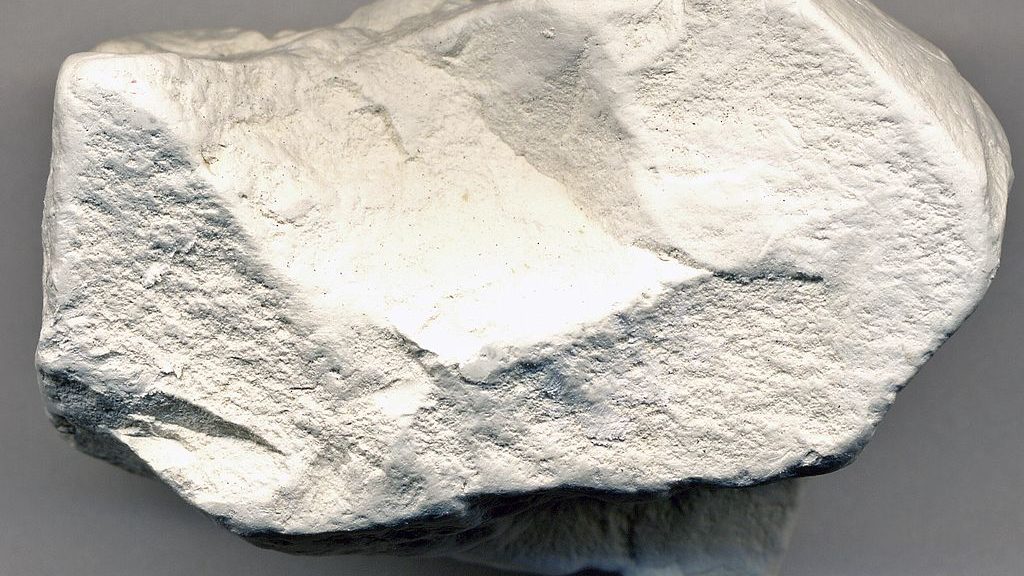
The Terrible Menace of Kaolin Pesticide!
This is the daily Merry Blogmas 2017 science post for December 18. | Did you even know that clay minerals like kaolin are used as pesticides? It came as a surprise to me, truth be told. I have had held some hefty pesticides and hazardous materials certifications over the years. So how did I ever miss knowing this?
Seriously, that sucking noise you hear is my tongue being removed from my cheek.
INTRODUCING KAOLIN
Koalin is a catch-all name for a commodity that includes kaolinite (Al2(Si2O5)(OH)4) and its two isomers, halloysite (Al2(Si2O5)(OH)4), and dickite (Al2(Si2O5)(OH)4). Isomers are compounds that share the same chemical formula but have different internal arrangements of elements.
Kaolinite is the main ingredient of kaolin. Other ingredient are presents in trace amounts.
Kaolin Uses
- Kaolin used to make porcelain.
- It’s biggest use is for coating paper.
- Many cosmetics and toothpastes include kaolin.
- Until the 1980s, kaolin was one of the ingredients of the popular anti-diarrhea medicine, kaopectate.
- The manufacturer replaced it with another clay, attapulgite.
- Attapulgite has some improved absorption qualities compared to kaolin.
- Attapulgite’s main attraction was its lower price.
- In the 1990s, kaopectate dropped all clay ingredients entirely.
- Starting in the 1990s, people started to use kaolin as a pesticide for vegetable crops and orchards.
THE DREAD PESTICIDE KAOLIN
To use kaolin as a pesticide, you spray or paint of slurry of it on the plants you want to protect. When the slurry dries, it forms a white-powdery coating. This coating lets the plant breath and still see sunlight. In addition, most insects can’t penetrate the coating to harm the plant.
As a pesticide, kaolin has many advantages. The most important is its benign affect on the environment.
- It’s not toxic if you ingest it, given its historical use as a medicine.
- Kaolin is not toxic when you smear it on your skin in cosmetics.
- It’s considered a low-toxicity substance if it gets into water and comes in contact with fish.
It does has one big downside and that’s its not-so-benign breathing hazard. Like all silicate minerals, it’s bad to inhale. Its short term effects are lung irritation. Its long-term effects are the nasty mineral-dust illnesses like silicosis.
So long as you take care not to breath any of it, though, kaolin is as friendly to the environment as it gets.
EPA Pesticide Labels
This following is not a tangent. This information is will be needed in just a few paragraphs.
The U. S. Environmental Protection Agency (EPA) regulates the use of pesticides. Part of the regulations include the Bible-like rule that the directions on the pesticide label are law. These labels are comprehensive. They include:
- Toxicology and chemical details.
- Application directions.
- Protective gear instructions.
- Medical first-response information.
- Clean-up measures to follow in the case of an accidental spill.
Ignoring what’s on an EPA pesticide label is illegal for any professional in the pest business.
The Wonders of PubChem
While PubChem info is both helpful and convenient, it has one big downside. It sometimes turns into nonsense because it’s a mishmash of cut-and-paste. Having used PubChem a lot, I think the folks who put these web pages together may lack the ability to make some needed edits.
PubChem General Description Example
Here are some quoted excerpts from the PubChem page on kaolin as an example:
- WHITE POWDER. – From ILO-ISCS –
- KAOLIN is an odorless white to yellowish or grayish powder. Contains mainly the clay mineral kaolinite (Al2O3(SiO2)2(H2O)2), a hydrous aluminosilicate. – From CAMEO Chemicals –
- White to yellowish or grayish powder. – From OSHA Occupational Chemical DB –
- White to yellowish or grayish powder. [Note: When moistened, darkens & develops a clay-like odor.] – From National Institute of Occupational Health and Safety –
This is typical for PubChem: cut-and-paste with lots of repetition. We get to see just about everyone’s description of kaolin.
PubChem Color Description Example
Let’s move on to descriptions of color for kaolin,
- White or yellowish-white, earhty (sic) mass or white powder; unctuous when moist – From the Merck Index –
- White to yellowish or grayish powder [Note: When moistened, darkens…] – From the NIOSH Pocket Guide –
- Triclinic. – From HSDB –
- White or near white … pseudohexagonal flakes. – From HSDB –
- Fine white to light-yellow powder. – From Sax, 11th Ed. –
Note the third entry under color. I’m still trying to figure out why triclinic, which is kaolin’s crystal class, is under color.
Isn’t cut-and-paste fun?
PubChem Vapor Pressure Example
I really like the entry for the vapor pressure. If you read this blog regularly, you may recall that we’ve already talked about vapor pressure. You may even remember that inert solids, like clay, don’t have a vapor pressure. Nonetheless, here’s the vapor pressure listing in PubChem for kaolin:
- 0 mm Hg (approx) (NIOSH, 2016) – From Cameo Chemicals –
Wow. A vapor pressure of zero for an inert solid like kaolin. Who would have thought?
That funny odor you’re detecting is the sweet smell of sarcasm…
PubChem Environmental Safety Example
The best part of the kaolin page from PubChem are the instructions for what to do if there’s an accidental spill of kaolin.
Spillage Disposal
Personal protection: particulate filter respirator adapted to the airborne concentration of the substance. Sweep spilled substance into covered containers. If appropriate, moisten first to prevent dusting. – From ILO-ISCS –
Cleanup Methods
Spillage Disposal: Personal protection: particulate filter respirator adapted to the airborne concentration of the substance. Sweep spilled substance into covered containers. If appropriate, moisten first to prevent dusting. – HSDB (quoting one vendor’s pesticide label for kaolin) –
Disposal Methods
SRP: The most favorable course of action is to use an alternative chemical product with less inherent propensity for occupational exposure or environmental contamination. – HSDB (quoting one vendor’s pesticide label for kaolin) –
Do not contaminate water when disposing or rinsing of equipment wash waters. – From USEPA/Office of Pesticide Programs; Reregistration Eligibility Decision Document – Kaolin –
PubChem Protective Equipment Example
Users should: A) Wash hands before eating, drinking, chewing gum, using tobacco or using the toilet. B) Remove clothing/ PPE immediately if pesticide gets inside. Then wash thoroughly and put on clean clothing. C) Remove PPE immediately after handling this product. Wash the outside of gloves before removing. As soon as possible. wash thoroughly and change into clean clothing. – HSDB (quoting one vendor’s pesticide label for kaolin) –
SRP: Contaminated protective clothing should be segregated in such a manner so that there is no direct personal contact by personnel who handle, dispose, or clean the clothing. – HSDB (quoting one vendor’s pesticide label for kaolin) –

SOURCES
- https://pubchem.ncbi.nlm.nih.gov/compound/kaolin
- https://www3.epa.gov/pesticides/chem_search/reg_actions/registration/fs_PC-100104_01-Jun-99.pdf
- http://www.ima-na.org/?page=what_is_kaolin
- https://www.mindat.org/min-2156.html
- https://www.mindat.org/min-1808.html
- https://www.mindat.org/min-1287.html
- https://toxnet.nlm.nih.gov/cgi-bin/sis/search/a?dbs+hsdb:@term+@DOCNO+630
- http://citeseerx.ist.psu.edu/viewdoc/download;jsessionid=1A8B59B0644151BD786DF1172B2F5383?doi=10.1.1.586.7437&rep=rep1&type=pdf
- http://www.jpharmsci.org/article/S0095-9553(15)34307-9/fulltext
- http://www.jpharmsci.org/article/S0095-9553(15)34325-0/fulltext
- http://www.jpharmsci.org/article/S0095-9553(15)34324-9/fulltext
The banner photo of the mineral kaolinite is by James St. John (2017), CC BY 2.0 via Wikimedia Commons

